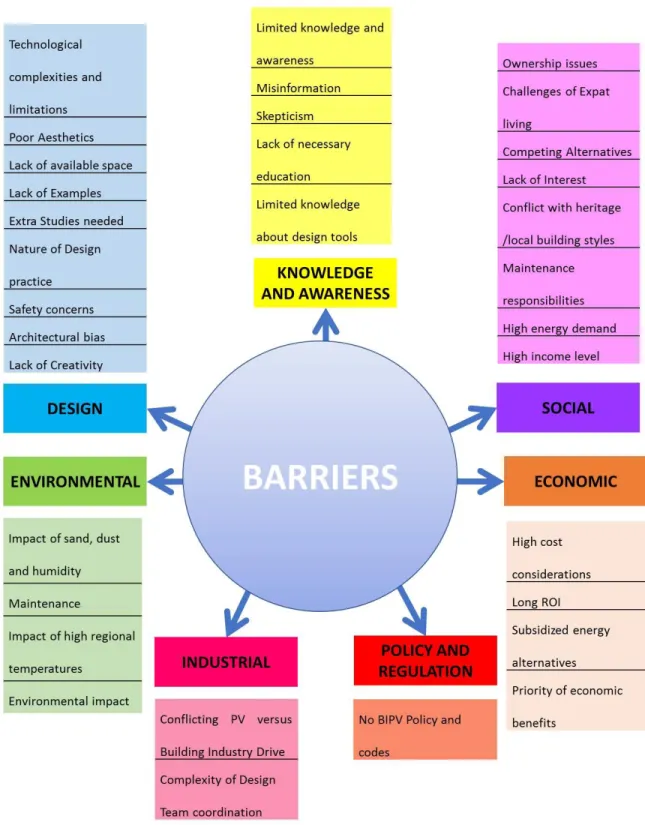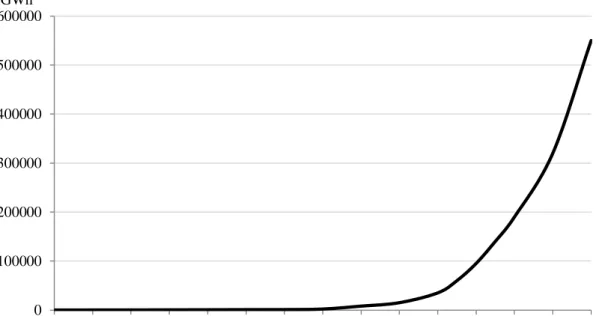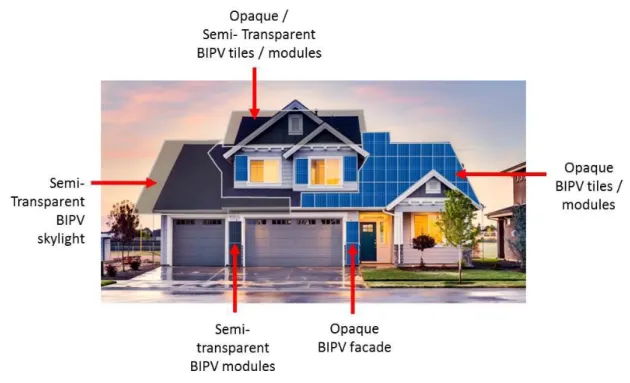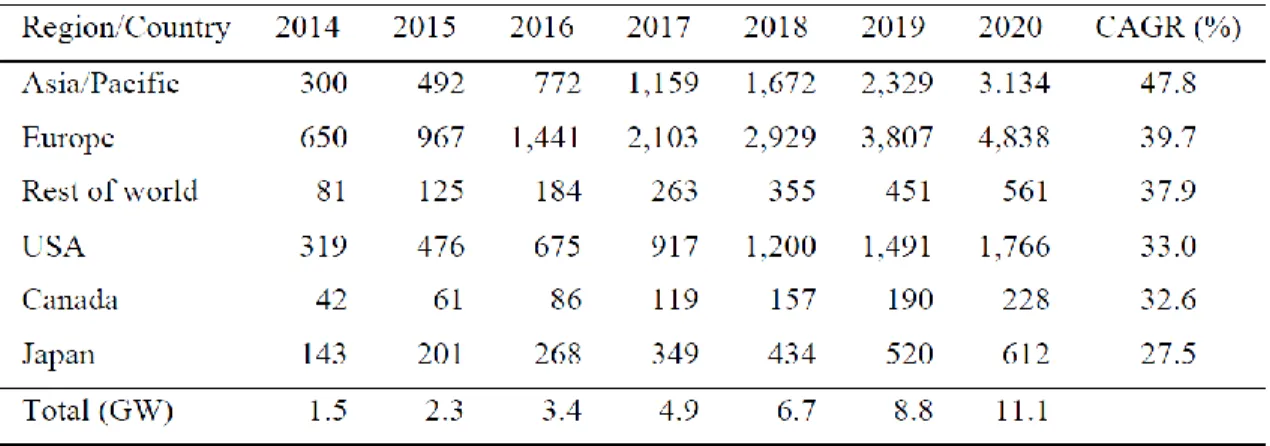Therefore, this thesis examines the current scenario to identify context-specific barriers and drivers by involving stakeholders in the UAE. These thematic connections were used to develop a trajectory for the adoption of innovative technologies in the UAE and beyond.
Introduction
- Preamble
- Problem Statement
- Research Aim and Objectives
- Research Justification
- Thesis Organization
In addition, public support for renewable energy-based electricity generation is another important driver (Singh, 2013; Tyagi et al., 2013). As a result, a framework and conceptual model for the adoption of BIPV in the UAE was developed.
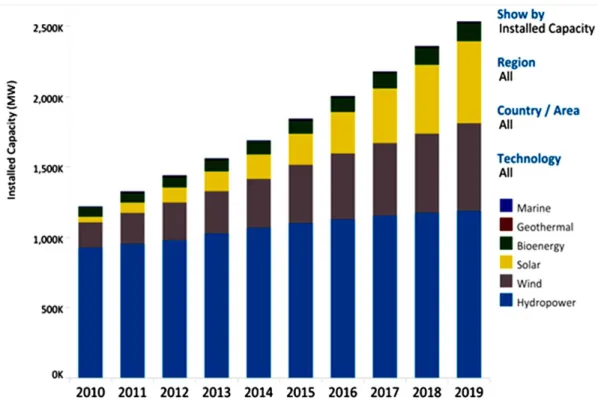
Literature Review
BIPV and the Innovation Dimension
- Innovation: Definition and Theories
- Innovation: Adoption Factors and Challenges
Also at the organizational level, the presence of leadership and an innovation champion (one who promotes innovation) are key to adoption. The findings of the study conducted by Ozorhon and Oral (2016) comparatively suggest that project-related factors are the main drivers of innovation.
The Significance of BIPV as an Innovative PV Technology
Environmental benefits can be at a micro level related to the project (Bakos et al., 2003; Sharples & Radhi, 2013) or at a macro/environmental level related to the less embodied energy of the materials (Morris, 2013). Social benefits imply a direct impact on the lives of individuals and the community in general (Montoro et al., 2011) and on public health and the environment (Yang & Zou, 2016).
BIPV Typologies: Classification and Adoption Trends
BIPV product types reflect building function and location as classified in literature (Jelle et al., 2012). BIPV adoption as reported by a market survey (Zanetti et al., 2017) shows variation in adoption of BIPV roof and BIPV facade solutions.
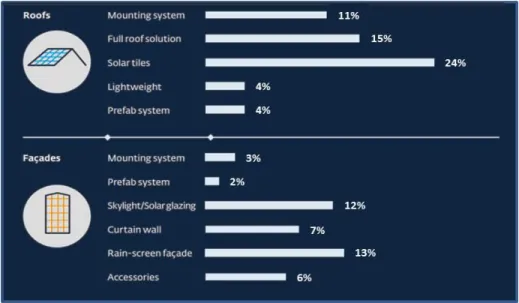
The Global BIPV Market
Based on the 50% growth of the market between 2014 and 2015 (Tabakovic et al., 2017), predictions of an accelerated growth of BIPV appeared in the literature. The strengths and weaknesses of the BIPV market were reviewed through SWOT analysis (Sudhakar et al., 2018).
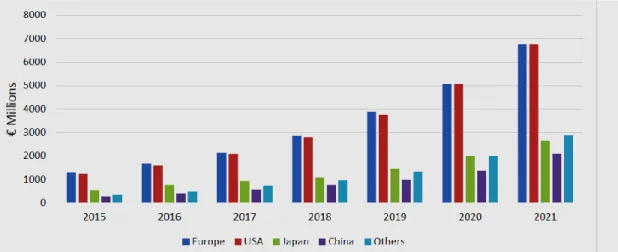
Prospects in the United Arab Emirates for BIPV
- The shift towards renewables
- Solar related investments and initiatives
- The role of Estidama: the local sustainability framework
The retelling of the comparative electricity costs in the UAE provides a consideration to orient the current discussion. It has been suggested that modernization in the built environment of the UAE has taken a greater toll on energy consumption.
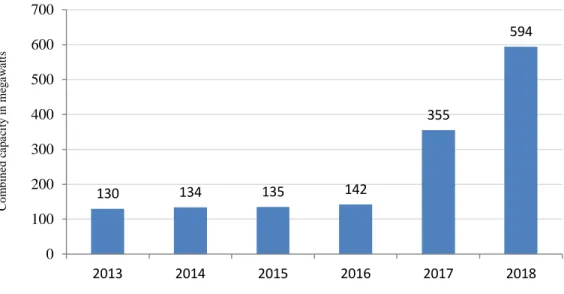
Stakeholders and BIPV Adoption
In the literature, the role of stakeholders in the adoption of BIPV has been investigated through a thorough review of their perspectives and opinions. This paper has created a picture of the barriers and drivers of BIPV adoption by systematically collating the findings of these studies.
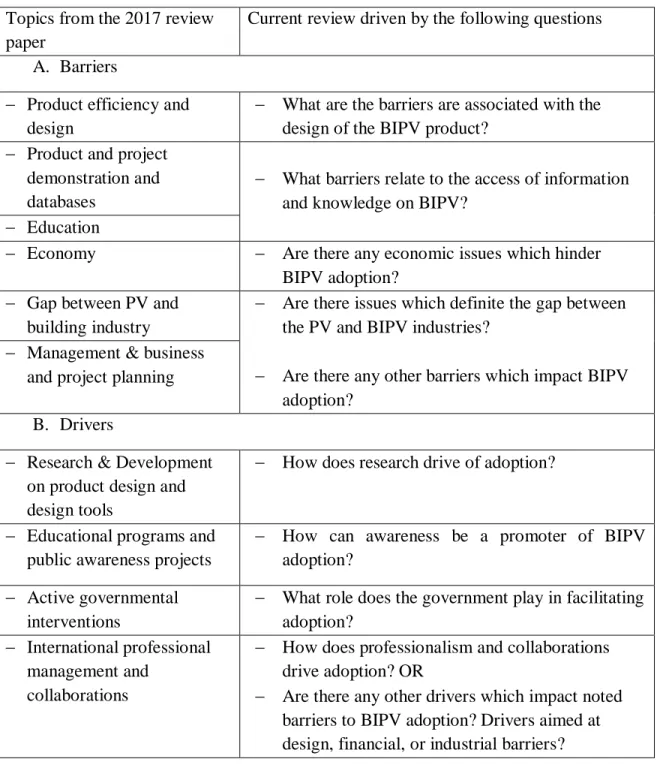
Barriers to BIPV Adoption
- What barriers relate to the access of information and knowledge on BIPV?
- What barriers are associated with the design of the BIPV system?
- Are there any economic issues which hinder BIPV adoption?
- Are there issues which define the gap between the PV and BIPV industries?
- Are there any other barriers which impact BIPV adoption?
In a review of the professional competence required for architectural design, it was also reported that there are few certified practitioners (Goh et al., 2017). One study reported that there is a strong bias against overwhelming and dominant technological PV appearances (Kosorić et al., 2018). In addition, the architectural integration of the technology is limited by the lack of appropriate products (Lu et al., 2019; Prieto et al., 2017).
The technical details and complexities of BIPV installation have been noted as a challenge to full adoption (Curtius, 2018; Prieto et al., 2017). Other studies found that economic feasibility was a concern in adoption (Prieto et al., 2017).
Drivers of BIPV Diffusion
- How can awareness be a promoter of BIPV adoption?
- How does research drive BIPV adoption?
- What role does the government play in facilitating adoption?
- Are there drivers which address the design process barriers?
- Are there drivers which address the industry-related barriers?
- Are there drivers which address cost-related barriers?
- Are there any other drivers of BIPV adoption?
Such projects can provide education and learning to motivate industry (Chang et al., 2019). Coordinated research and development should also be encouraged, which should also be aimed at facilitating the exchange of knowledge (Osseweijer et al., 2018). The reported effect of these incentives and support policies includes an increase in cost-effectiveness (Prieto et al., 2017).
Others include stimulating the market (Chang et al., 2019) and a change in energy consumption and behavior (Stauch & Vuichard, 2019). It has also been reported that the value of aesthetically pleasing products can be used as a marketing tool with homeowners (Hille et al., 2018).
Gaps in the Literature on BIPV Adoption
It has been discovered that when people have neighbors, friends or family who have already installed BIPV, they are also likely to adopt the technology (Petrovich et al., 2019; Curtius et al., 2018). The studies noted that the association between social ties, community role models and the influence of peers was significant, creating a kind of social pressure to conform (Curtius et al., 2018; Petrovich et al., 2019). For example, Tabakovic et al. 2017) focuses mainly on facilitating adoption by involving education and BIPV courseware development, while Mousa (2014) prioritized the role of architects in the adoption of BIPV.
The literature on BIPV adoption trends appears to omit these theoretical records; one study (Wolske et al., 2017), focused on residential solar in general, raised this need to connect theory with practice and research. Only a few studies have initiated the necessary mechanisms to emphasize the debate in this direction (Ritzen et al., 2016; Wall et al., 2018; Zanetti et al., 2017).
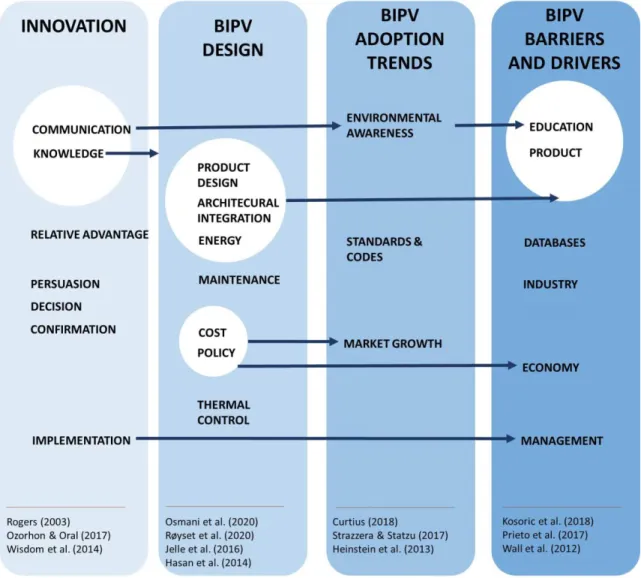
Conclusion
Methodology
Introduction
Research Design
- The Use of Interviews
- Participant Selection and Sampling
For example, Muysken and Nour (2006) noted that about 90% of the workforce in the United Arab Emirates is non-native. Establish the opinions and perspectives of participants in the context of the BIPV development field. This process essentially allows an emphasis on the social positioning of research data and allows the researcher to use spontaneity in the process of seeking answers to complex issues (Cohen et al., 2013).
It was therefore critical to identify key informants in the UAE whose perspectives would provide a credible and holistic view of the BIPV adoption barriers and/or drivers. However, with specific reference to the study context, further considerations were defined in the selection of study participants.
Data Collection
- Two Interview Phases
- Question Development
- Preliminary Data Collection Phase: Informal Conversational Interviews (ICI)
- Insights from the ICI Findings
- Main Data Collection Phase: The Semi-Structured Interview (SSI)
- Semi-Structured Interview (SSI) Protocol
- Pilot SSIs
- Study Participants and Interview Process of the Main Study
Findings in the literature and in the ICI were compared to identify questions of critical or unique relevance to the study area to help focus the SSIs. This comparison was used in the design of the interviews for the SSIs as described in the next section. In addition to this, SSI's next focus was to simultaneously explore how to address these various barriers, ie.
Consequently, it was decided to ask specific questions about barriers and drivers, based on the interest group of the participant. The final draft of the SSI protocol referred to in Appendix 2 also highlights the refinements to the protocol that.
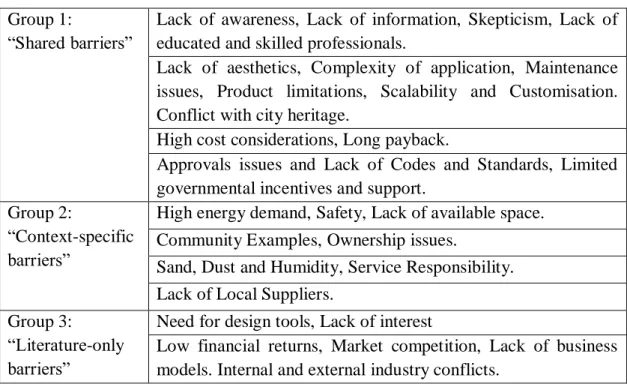
Number of participants
Interview Process
The schedule for each interview was agreed based on each participant's request to ensure that the time and place were acceptable, and the individual was comfortable and in the best state of mind. All interviews were conducted in English as most of the participants are native English speakers. General introductory questions regarding the participant's background, occupation and length of stay in the UAE were asked before discussing the research.
For these non-technical participants, it was also necessary to describe the topic in layman's terms; rather than saying "Integrated photovoltaic buildings", explanations such as, "solar panels used to replace this wall, or roof, not just placed on top of the roof" were used. At the end of the interviews, some participants noted that although the topic appeared technical, the questions were clear and the discussion was not boring.
Data Analysis Process and Summary
- Coding
- Data Reduction, Extraction and Collation
- Data Presentation and Chart Building
The aim is to identify important or interesting themes to address the research question while systematically attempting to make sense of the data collected. The results of the theme building process yielded several themes for barriers and drivers respectively. Design: this is related to limitations of the PV technology, the design process and considerations, and the BIPV product, such as poor aesthetics.
These two chapters present the comments of the study participants constructed into a narrative that explains the influence of each on the adoption of BIPV in the UAE. The use of figures and graphs was used to facilitate the presentation and organization of the codes, grouped into groups.
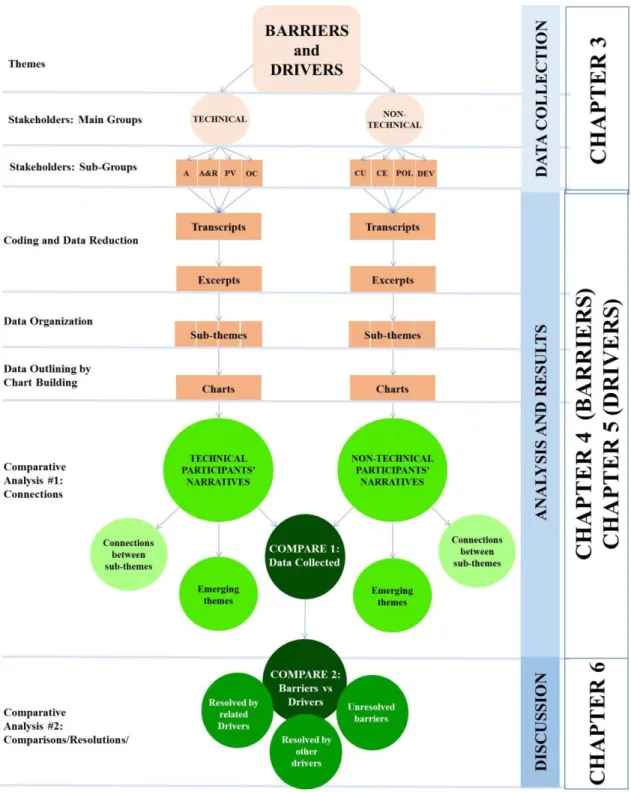
Reliability and Validity
Thick Description: The study results were detailed as they relate to BIPV's knowledge or perception of barriers and drivers.
Research Ethics
Direct participant quotes were used to create a single narrative around these two key research objectives. Prior to data collection: Clarity of the purpose of the research was sent to the study participants in writing to remove any ambiguities and uncertainties. During data collection: formal and respectful greetings and a restatement of the research objective were used to begin each interview.
Informed consent to record and use the collected data was obtained from all study participants. After data collection: the entire data set of recorded interviews and transcripts was kept in the sole possession of the researcher.
Limitations of the Study
However, while a few participants said they didn't mind if their names were mentioned, others declined the request to record but allowed notes to be taken. For reasons of respect and uniformity, no names of participants were used in this study, but codes were used to identify participants. The researcher also conducted multiple interviews using the same protocol to improve the consistency of the collected data.
Second, it was difficult to obtain permission to collect data from some participants, which caused the data collection phase to extend longer than expected. Multiple emails, phone calls, personal and third-party solicitations were used with a continuous devotion to reach as many representatives from each stakeholder group as possible to resolve this.
Conclusion
Analysis and Findings Barriers to Adoption
- Thematic Analysis: Barrier Themes Identified
- Knowledge and Awareness
- Design
- Social
- Economic
- Environmental
- Policy and Regulation
- Industrial
In the current study, excerpts from comments from nine participants – four and five, from the technical and non-technical groups, respectively – highlight this barrier. a) Opinions of technical participants. He suggested that expats are not motivated to invest in 'the future' because expats cannot choose to retire in the UAE – creating a sense of 'not really being a member of society' (R05AE) . One developer explained that this is because “the market is still young and undeveloped” and also stressed that there is some uncertainty about the cost of BIPV over the entire project timeline (R68D).
The six non-technical participants who commented on this barrier show that there is some general appreciation for the challenge of BIPV in the region. They agree that dust is the main problem because there is a lot of it (R52CE; R63CE; R64PM) and one added that “the weather itself is salty”. R64PMI), noting that this is also a problem for the solar panels. One participant added: “the panels need to be cleaned regularly and they require quite a lot of water, which is something that puts people off.” This last comment was made by a mechanical engineer who had done some research with solar panels in the UAE and he added that not only is the maintenance intensive – but the main problem is the unplanned maintenance; that kills you” (R28OCE).
This barrier assesses the impact of this rise in temperature on the efficiency of the BIPV system in the UAE. a) Opinions of technical participants.
